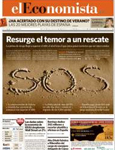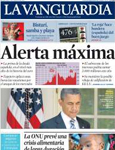 The hike in the risk premium for Italian and Spanish debt (Spain's spiralled to 403 basis points relative to German bonds and closed above 380) ended up driving both countries into an emergency situation on August 2. The political alarm triggered by the unending punishment from the financial and stock markets has forced consultations among the Prime Minister, José Luis Rodríguez Zapatero, and the opposition parties to analyse possible responses to the serious deterioration in Spain’s creditworthiness and to avert fears about a possible bailout of Spain, which Brussels has denied.
The hike in the risk premium for Italian and Spanish debt (Spain's spiralled to 403 basis points relative to German bonds and closed above 380) ended up driving both countries into an emergency situation on August 2. The political alarm triggered by the unending punishment from the financial and stock markets has forced consultations among the Prime Minister, José Luis Rodríguez Zapatero, and the opposition parties to analyse possible responses to the serious deterioration in Spain’s creditworthiness and to avert fears about a possible bailout of Spain, which Brussels has denied.
The constant battering of the markets against Spanish and Italian debt is threatening the very survival of the euro zone, which is practically exposed out in the open for lack of political resources still needed to ward off speculation against the national debts.

The diagnosis is already in, but Europe persists in failing to tackle the roots of the Greek crisis and in failing to present the image of a unified economic governance. Meanwhile, Spain and Italy remain trapped in the insoluble contradiction that arises when a drastic fiscal adjustment plan is applied. The deeper the cuts required of a country, the further the fall in their expectations of growth. Investors understand that without growth there can be no return of the financing they loaned. The cost of refinancing therefore goes up, and in turn the tourniquet tightens on their already somewhat diminished activity. And so on, until a bailout becomes inevitable.
The month of August will be a tough test for Spain and Italy. Investors have not set much value on the bringing forward of elections, as the early elections weigh in rather marginally next to the economic factors mentioned, such as the stunted capacity for growth (Spanish GDP will, hopefully, grow by 0.7 percent this year), the stagnant world economy (evident in the case of the U.S.) and the dire political mismanagement of the crisis in Europe.
Choosing between bad and worse…

Neither Germany nor the ECB have finished carrying out the financial reform criteria set out in the last European summit. Meanwhile, Europe is sliding into an irreversible crisis. If Italy and Spain, the third and fourth largest economies in the euro zone, were forced to fall back on a rescue plan, the disaster for the single currency would be complete.
The wriggle room for the Spanish government is somewhere between bad and worse. If the risk premium does not drop, the rising cost of servicing the debt will devour any such room for manoeuvre that public policy may still have. The recovery is hard enough with a spread of over 100 basis points; at 400 points, it is impossible to break the deadlock, create jobs and make any significant dent in unemployment.

One orthodox response (suggested by the IMF) would be to present to Europe and to the markets an additional budget cut of about 2 percent of GDP. But that decision would have impacts on growth equivalent to the strangulation that is producing the unbridled rise in financing costs. It would mean giving up any recovery for the next five years
The die is cast. And, facing the failure of the most orthodox formulas, new ways forward must be found. One would be immediate and decisive action by the ECB (massive buying of Spanish and Italian debt). Another would be the acceptance of a European debt to replace national debts.
Eurozone
Remedy won't be available soon
Faced with the prospect of the Eurozone crisis spreading to Spain, Italy and Cyprus, "Eurozone governments are accelerating efforts to bolster their €440bn rescue fund", reports the Financial Times. On July 21, "they agreed to equip the EFSF with the ability to repurchase the bonds of stricken governments on open markets, provide them with short-term lines of credit and cash to help recapitalise ailing banks." With Spanish and Italian risk premiums on the rise, "the ability to repurchase Spanish or Italian bonds at distressed prices would be one way to help stabilise the markets".
"Yet European diplomats and officials acknowledged that it would be weeks – and possibly months – before the EFSF’s new powers could be put to use", notes the FT, reporting that officials of the Eurozone are accelerating their work to produce a draft document. The final text would then have to "be signed by the 17 Eurozone governments, and then undergo a ratification process that includes parliamentary approval in most of those countries."
Was this article useful? If so we are delighted!
It is freely available because we believe that the right to free and independent information is essential for democracy. But this right is not guaranteed forever, and independence comes at a cost. We need your support in order to continue publishing independent, multilingual news for all Europeans.
Discover our subscription offers and their exclusive benefits and become a member of our community now!












